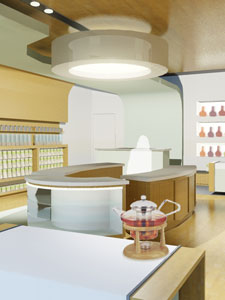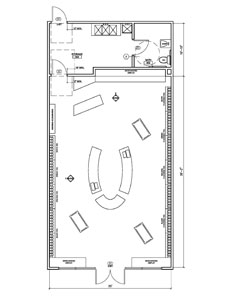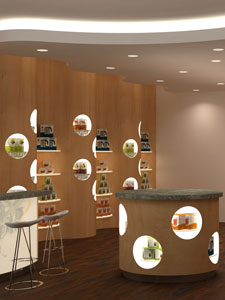Store Design Part 1: Strategic Elements



For a consumer, the design of a retail store appears simple and straightforward. We quickly absorb thousands of pieces of sensory information and make a snap judgment on whether or not we "like" the store and its products. To properly understand this process and design a store that will welcome the customer, drive sales and run efficiently is anything but simple. In this article I'll attempt to describe a few of the key strategic elements to be considered when designing a retail store. In Part 2 I'll describe the strategies that we're planning to implement in Adagio's pilot retail store.
Effective retail store designs require an understanding of work-flow, consumer behavior, and functional aesthetics.
Work-flow in this case refers to the interaction of each of the moving parts in the operation. I'll give just a few of the key questions that must be answered prior to creating a simple floor plan:
I could continue for several pages, but you start to get the idea. You need a VERY well defined vision for exactly how your store will run in order to make even basic decisions like how many square feet you need and how to set up your displays.
Consumer Behavior refers to the way your target customer will react to the store layout, merchandising strategies, design elements, customer service strategies, etc. You will need a solid understanding of your customer, what they like, and WHY they are in your store. Are you targeting tea connoisseurs or novices? Is the store set up to drive food service business (brewed tea and food or pastries) or retail business? Is your customer a luxury buyer who expects a clean, brightly lit store with professional packaging and slick merchandising or is your customer more of a "buy local" type who will be turned off by an environment that is too professional and expensive looking?
Another important question: will most of your customers expect to be helped by a sales associate or do they prefer browsing on their own? The answer to this one question will completely change your store design and staffing strategies. I refer to this balance as "Consultation vs. Convenience". The truth is that different people prefer shopping in different ways. I am the type that automatically rejects any offer of assistance from a sales person whether I really need help or not. It's just instinctive for me. I don't want to be sold. Others will walk up to the counter and ask the sales person to do their shopping for them. For example, I've had many customers (especially men) walk up to my counter and tell me that they need to buy a tea gift for a tea lover but know nothing about tea themselves and really don't care - what do I recommend?
Functional Aesthetics refers to the often difficult to predict way that design elements and products will appear when in use in the store. I combine these two words intentionally because store design is all about balancing efficiency with appearance. The refrigerator for iced teas, milk and pastries is incredibly useful but may also be unattractive and noisy. The clean lines and uncluttered appearance of your tea displays may look beautiful, but is enough information being presented so that an unfamiliar customer can quickly and easily navigate the product collection and find what they are looking for?
I'll give a specific example that is a pet peeve of mine: Round bulk storage containers have a terrible functional aesthetic! When first designed, your store may look fantastic, but an hour after the doors open on the first day your displays already look like a cluttered mess with labels facing all different directions. Or consider a round sample jar with a label on one side... how often will the customer put that jar back on the shelf with the label facing backwards? It's a small, simple problem, but solving it may be far more important than you realize.
The number one obstacle that you must overcome in designing your store is the customer's natural tendency to get overwhelmed when walking into an unfamiliar environment. A customer that is overwhelmed, uncertain and embarrassed by their own lack of knowledge will never be a profitable customer. Consider two very different strategies for merchandising clothing: In a discount store you will often find a large, round rack of clothing jam-packed with all manner of different colors and designs that are, theoretically, organized by size (S,M,L). Walk into a luxury boutique and you find a single display dedicated to a single design with different rows for each different size. The discount store lends itself towards frustration and is highly inefficient in connecting the customer with what they are looking for. The luxury boutique is beautiful and easy to navigate, but is highly inefficient in terms of the square feet of space dedicated to a single item. The right answer for your store is likely somewhere in between, but understanding how all of the elements in the store will work together and appear (sight, smell and sound) when actually in use is critical.
The moral of the story is that store design is a lot like art. We know "good art" when we see it, but few of us are able to create it ourselves. For the most part that is because we don't understand or appreciate all of the little techniques to art, and store design, that make all the difference. I had the privilege of starting my career in tea opening stores for TeaGschwendner, the world's largest specialty tea retailer with more than 145 stores in 9 countries on 4 continents. They've been in the tea business for more than 30 years now and have developed a very refined, efficient and beautiful retail model. I spent thousands of hours behind the counter and behind the scenes building a detailed understanding of the work-flow, consumer behavior and functional aesthetics of a TeaGschwendner shop. Many of the elements that I thought in the beginning needed to be changed for the US market, I later concluded were perfect just they way they are. For all of my experience and common sense, I cannot imagine trying to design the Adagio retail store strategy without this experience.
For anyone considering opening a shop of their own, I highly recommend spending some time working in a tea shop or similar retail environment at least part time for a few months. Being a tea drinker and a retail customer makes you no more qualified to design a retail space than being a food eater and restaurant goer makes you qualified to be a 4-Star chef! I'm sure that most people will get the store 80% right on the first try, but what is the cost of that missing 20%? Being wrong, even in little ways, is a lot more "expensive" than simply making changes to your store design after the fact. Most of the tea drinkers and tea curious in your area will walk through the doors to your new store in the first few weeks after you open. They will make a snap judgment on the quality of your store and your product based on the thousands of little factors that you may or may not have considered. If their judgment is that your store is lacking, they'll never come back to witness the changes you make. You may not get a second chance!
In Part 2 of this series I'll discuss the objective behind our move into physical retail stores. In Part 3 I'll share some of the tactical strategies we plan to implement in Adagio pilot retail store.
Adagio Teas
Twitter: @AdagioRetail
